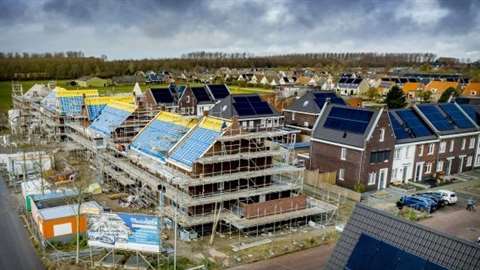EU construction output to grow by 2.5% in 2022
16 February 2022
 New homes being constructed in Stellendam in the Netherlands (Photo: ING)
New homes being constructed in Stellendam in the Netherlands (Photo: ING)
The European constuction sector is expected to grow by 2.5% in 2022, as a result of “fresh investment from the EU recovery fund, according to global economic analysis specialist ING.
In its latest EU Construction Outlook report, the company said that despite price pressures, business confidence at the beginning of 2022 was positive among most contractors in the European Union, and back to pre-covid levels.
The research also revealed that the EU infrastructure sector grew by 1.5% (year on year) in November 2021. This is after almost no growth (+0.2% year-on-year) for the same period a year earlier.
While there are large differences between countries, the report said that production levels in the infrastructure sector across the whole of the European Union have been quite stable for the last 10 years.
Currently building volumes are being boosted by new investments from the EU Recovery fund whilst ongoing housing shortages and high house prices provide structural demand for new residential construction.
Furthermore, non-residential construction will see a rebound as the Covid-crisis fades, and entrepreneurs are less reluctant to invest in new company premises or renovate their existing properties, said ING.
A record number of building companies are planning to increase their prices at the beginning of 2022.
On balance, 36% of EU building firms plan to increase prices in January 2022. It is said that German, Austrian and Dutch construction firms, in particular, are expected to raise their sales prices.
The construction sector in Germany has been quite resilient during the Covid crisis, said ING, but for Spain, they forecast recovery of construction volumes this year and next but it won’t make up for the large drop from the last two years.
ING also forecasts further recovery in France and Belgium this year and next year.
France has recently implemented a new law requiring half of the materials used in public buildings to be timber or other bio-based materials. This has led to increasing demand for these specific materials and shortages, especially as timber is still scarce.
Shortages are also said to be high in Germany, Austria and the Netherlands as production levels have remained high in these countries.
ING expect that building material shortages will continue for a while, not least because of China’s ‘zero-Covid’ strategy and restrictions put in place to contain the virus in cities and ports that are very important to global production chains.
In general, ING said their EU Construction Outlook remains optimistic. Despite the shortages of building materials and structural shortages of labour, they expect further growth in the EU construction sector in 2022 and 2023.
STAY CONNECTED



Receive the information you need when you need it through our world-leading magazines, newsletters and daily briefings.
CONNECT WITH THE TEAM









